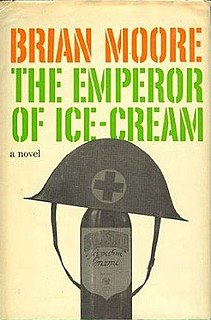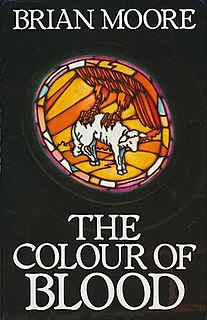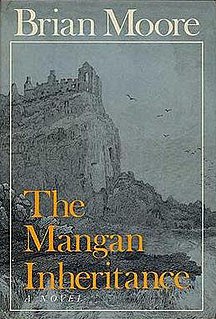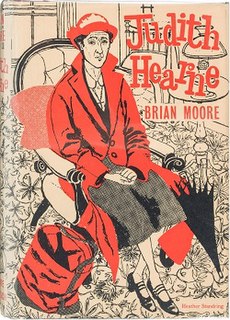
Patricia Highsmith was an American novelist and short story writer widely known for her psychological thrillers, including her series of five novels featuring the character Tom Ripley.

Gene Eliza Tierney was an American film and stage actress. Acclaimed for her great beauty, she became established as a leading lady. Tierney was best known for her portrayal of the title character in the film Laura (1944), and was nominated for an Academy Award for Best Actress for her performance as Ellen Berent Harland in Leave Her to Heaven (1945).

I Am Mary Dunne is a novel, first published in 1968, by Northern Irish-Canadian writer Brian Moore about one day in the life of a beautiful and well-to-do 31-year-old Canadian woman living in New York City with her third husband, a successful playwright. Triggered by seemingly unimportant occurrences, the protagonist / first person narrator remembers her past in a series of flashbacks, which reveal her insecurities, her bad conscience concerning her first two husbands, and her fear that she is on the brink of insanity.

Brian Moore, was an Irish-born Canadian novelist and screenwriter, who emigrated to Canada and later lived in the United States. He was acclaimed for the descriptions in his novels of life in the north of Ireland during and after the Second World War, in particular his explorations of the inter-communal divisions of The Troubles, and has been described as "one of the few genuine masters of the contemporary novel". He was awarded the James Tait Black Memorial Prize in 1975 and the inaugural Sunday Express Book of the Year award in 1987, and he was shortlisted for the Booker Prize three times. Moore also wrote screenplays and several of his books were made into films.

St John Greer Ervine was an Irish biographer, novelist, critic, dramatist, and theatre manager. He was the most prominent Ulster writer of the early twentieth century and a major Irish dramatist whose work influenced the plays of W.B. Yeats and Sean O'Casey. The Wayward Man was among the first novels to explore the character, and conflicts, of Belfast.

Richard Rowley was the pseudonym of Richard Valentine Williams, born at 79 Dublin Road, Belfast, Ireland, who wrote poetry, plays and stories.
Forrest Reid was a Northern Irish novelist, literary critic and translator. He was, along with Hugh Walpole and J. M. Barrie, a leading pre-war novelist of boyhood. He is still acclaimed as the greatest of Ulster novelists and was recognised with the award of the 1944 James Tait Black Memorial Prize for his novel Young Tom.

The Statement (1995) is a thriller novel by Northern Irish-Canadian writer Brian Moore. Set in the south of France and Paris in the early 1990s, The Statement is the tale of Pierre Brossard, a former officer in the pro-Fascist militia which served Vichy France, and a murderer of Jews. It was published by Bloomsbury in the United Kingdom in 1995 and by E.P. Dutton in the United States on 1 June 1996.

The Revolution Script is a fictionalised account by Northern Irish-Canadian novelist Brian Moore of key events in Quebec's October Crisis – the kidnapping by the Quebec Liberation Front of James Cross, the Senior British Trade Commissioner in Montreal, on October 5, 1970 and the murder, a few days later, of Pierre Laporte, Minister of Labour in the Quebec provincial government. It was published in Canada and the United States at the end of 1971. The British newspaper The Sunday Times reproduced excerpts from the book and it was published in the United Kingdom in January 1972.

The Emperor of Ice-Cream is a 1965 coming-of-age novel by writer Brian Moore. Set in Belfast during the Second World War, it tells the story of 17-year-old Gavin Burke who, admitting “War was freedom, freedom from futures,” defies his Nationalist and Catholic family by volunteering as an air raid warden with the largely Protestant ARP. The novel takes you through Gavin's journey as he realises that there are those on the other side of the city's bitter communal division whose friendships offer a wider horizon.

The Colour of Blood, published in 1987, is a political thriller by Northern Irish-Canadian novelist Brian Moore about Stephen Bem, a Cardinal in an unnamed East European country who is in conflict with the Roman Catholic Church hierarchy and finds himself caught in the middle of an escalating revolution.

The Mangan Inheritance, published in 1979, is a novel by Northern Irish-Canadian writer Brian Moore. Set in Ireland, it tells the story of a failed poet and cuckolded husband, James Mangan, who discovers a daguerrotype of a bohemian Romantic Irish poet with the same surname and seeks out connections to his literary ancestor.

Judith Hearne, was regarded by Northern Irish-Canadian writer Brian Moore as his first novel. The book was published in 1955 after Moore had left Ireland and was living in Canada. It was rejected by 10 American publishers, then was accepted by a British publisher. Diana Athill's memoir Stet (2000) has information about the publishing of Judith Hearne.

No Other Life is a novel by Northern Irish-Canadian writer Brian Moore, published in 1993.

Fergus, a novel by Northern Irish-Canadian writer Brian Moore, was published in 1970, in the United States by Holt, Rinehart and Winston. It tells the story of Fergus Fadden, a 39-year-old Irish-born writer living in California, who is haunted by ghosts from his past, including that of his father.

The Doctor's Wife is a novel by Northern Irish-Canadian writer Brian Moore, published in 1976. Shortlisted for the Booker Prize, it tells the story of Sheila Redden, a doctor's wife from Belfast, who takes an American lover eleven years her junior while in Paris. She then separates from both her husband and her new lover.
Sam Hanna Bell (1909–1990) was a novelist, short story writer, playwright, and broadcaster who lived in Northern Ireland.
Patricia Craig is a writer, anthologist and literary critic from Northern Ireland, living in Antrim, County Antrim.
Denis Sampson is an acclaimed Irish writer and literary critic who was born in Whitegate, County Clare in Ireland in 1948 and now lives in Montreal, Canada. In 2015 he wrote a memoir, A Migrant Life, about his rural Irish childhood and his passion for books. He is review editor for the Canadian Journal of Irish Studies and an English teacher at Vanier College, Montreal.
Brian Moore's early fiction refers to the seven pulp fiction thrillers, published between 1951 and 1957, that the acclaimed novelist Brian Moore wrote before he achieved success and international recognition with Judith Hearne (1955) and The Feast of Lupercal (1957).















